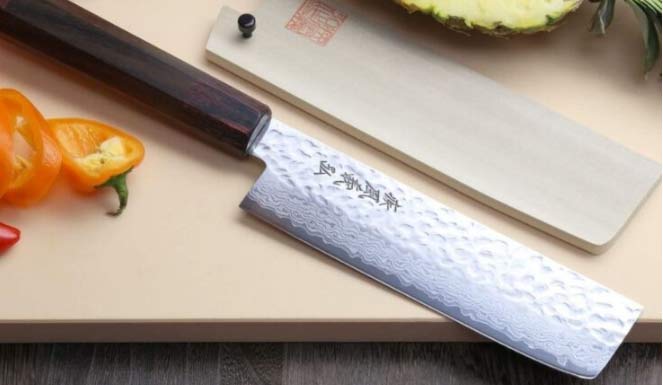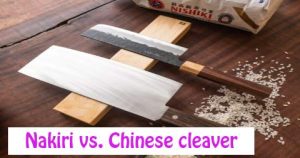Cleaver is a generic term used for knives with rectangular blades having a straight spine which is parallel to the belly and a high heel that meets a flat toe. Majority of the cleaver knives are thick, heavy and used for separating the bones and meat while many others are thin and highly sharpened. On the other hand, the nakiri are used for slicing and chopping the fruit and vegetables.
There are various types of cleaver available and used for different purposes, in fact you can say that nakiri is one of them. But to provide the facility to our users, we have done a comparative analysis and described the difference between nakiri and Chinese cleaver knives. Both nakiri knives and chinese cleaver are perfect companions in your kitchen but I know you will be stuck deciding which one should i select. To clarify all these things including what both knives are good for, what sets each apart, and how to choose the option that best serves you in the kitchen we have covered the topic “ Nakiri vs chinese cleaver ”.
Nakiri Overview
When you see the nakiri first time you will wonder about its name and you will not see its rectangular shape and flat blade out of place in a butcher shop but still it is highly versatile as compared to your expectations. It is mainly designed for thinner and more complex cutting of food. It is also an ideal knife for dealing with denser pieces of meat. It is light in weight and is used as a chef knife as well in most kitchens.
Hand Motion
The shape of the handles means you’ll use a different hand motion to use them than you’re friendly with. Compared to other western rocking motions, you will move your hand in an up and down motion. It looks a little curved at first until the user gets used to it but still has a lot of value in our proposition. Nakiri knives always have a balanced handle and wide body structure for various kitchen tasks.
Nakiri History
During Edo’s era in Japan, it was prohibited to eat animals that have four legs. That’s why the majority of people consume vegetables, rice and fish then eventually the nakiri knife appears which is the historical backdrop of this knife. Now nakiri knife is too much for preparing traditional japanese meals and also considered as a fantastic option.
Nakiri Knives Uses
Nakiri Basic Statistics
Chinese Vegetable Cleaver Overview
The appearance of traditional chinese vegetable cleaver is similar to nakiri knife. It also has a rectangular blade, although with a tip that ends in a straight line rather than a slightly curved edge. Furthermore, They are collectively-longer than the nakiri with a thicker blade overall. You can estimate it now, these knives are perfect for soft vegetable preparation and handling kitchen tasks preparation.
Blade Height
Another feature of Chinese vegetable cleaver knives is its height. The blades of these knives are generally taller than nakiri rivals. These specialties make a great option for larger vegetables and thicker meat. Thicker cuts are easier due to the extra weight, height and thickness of the blade.
Hand Motion
Like a nakiri knife, the Chinese cleaver is used with an up and down hand motion. Keep in mind that the long blades of most Chinese cleavers mean that you may need to brush up on your technique here if you’ve never used a non-Western knife before.
Chinese Cleaver Uses
Vegetable Cleaver Basis Statistics
Nakiri vs Chinese Cleaver – What are the Difference


In the first section, we have described both nakiri and chinese cleaver similarities, now lets move to see the differences between them. The major differences are their weight and height. Chinese cleaver is slightly heavier than nakiri knives. Both knives have thick and taller blades and could be used widely for different tasks in the kitchen as alternately chef tasks. Although, Chinese cleavers are better for thicker cuts and Japanese nakiri knives are better for Japanese cuisine.
The Differences in a Table
| Knife | Cleaver | Nakiri |
| Blade Length | 6-8 inches | 5-7” |
| Blade Thickness | 1/32 to ⅓ of an inch thick | Between 0.06″ and 0.10″ – double-edged |
| Flexibility | Moderate | Low |
| HRC | 54-56 (but can vary) | 59-62 |
| Main Purpose | Preparing vegetables, general kitchen prep, and deboned meats. | Clean, thin, fast cuts. Meat prep |
Shape
Most chinese cleaver knives have a flat blade tip while nakiri knives lack a sharp tip but it has a feature of a little bit curve toward the close end of blade. If we talk on average level, the chinese cleaver gives a taller blade while nakiri knife has a thinner blade.
Weight
A Chinese cleaver is always heavier than a paring knife, this is a universal rule and it has weight distribution characteristics that can take a minute to get used to. For this reason, they are mainly used for heavy duty tasks. The sophistication and intricate cuts we get from Nakiri should not be dismissed.
Which One Should We Choose
Are you preparing a lot of vegetables that require a little extra weight after each cut? A Chinese clover would be a great option for you. If you really like Japanese food and want to make consistently fine cuts, you have the option of a nakiri knife. Despite all these possibilities, we still recommend that you try each knife in person before making a decision. If you’ve only used Western-style knives before, it may take some time to get used to the cutting motion required and the weight distribution on offer.
Nakiri’s Pros & Cons
Pros
Cons
Cleaver’s Pros & Cons
Pros
Cons
Frequently Asked Questions
What is the Best Nakiri Knife ?
Shun premier nakiri is the best nakiri knife to use. As the shun is a reputed knife-making hundred years old company. They are making knives himself using traditional Japanese knife and sword making techniques. Other quality nakiri knife makers are miyabi and dalstrong.
What is the Best Chinese Vegetable Cleaver ?
Shun 7 inch chinese cleaver is such a great and super quality cleaver knife. From its blade material, design to edge retention everything is well settled.
What is a Nakiri Knife Used For ?
Nakiri knife is a Japanese kitchen knife which is widely used for chopping up different vegetables and mincing small pieces of garlic. It has a straight edge blade and long length blade as compared to other knives.
Final Verdict
Here you have a complete overview of the uses and features of these two blades. Now, the right model for you will largely depend on your own needs and preferences in the kitchen. If you think you’ll be working mostly with vegetables and fish, and you already have a chef’s knife handy, a nakiri knife would be a great addition. However, if you need a heavy blade that can cut through thick meat, cartilage, and bone, you need a cleaver. So, be sure to ask yourself, what do I need in my kitchen? And from there, finding the right knife for you will be much easier!

